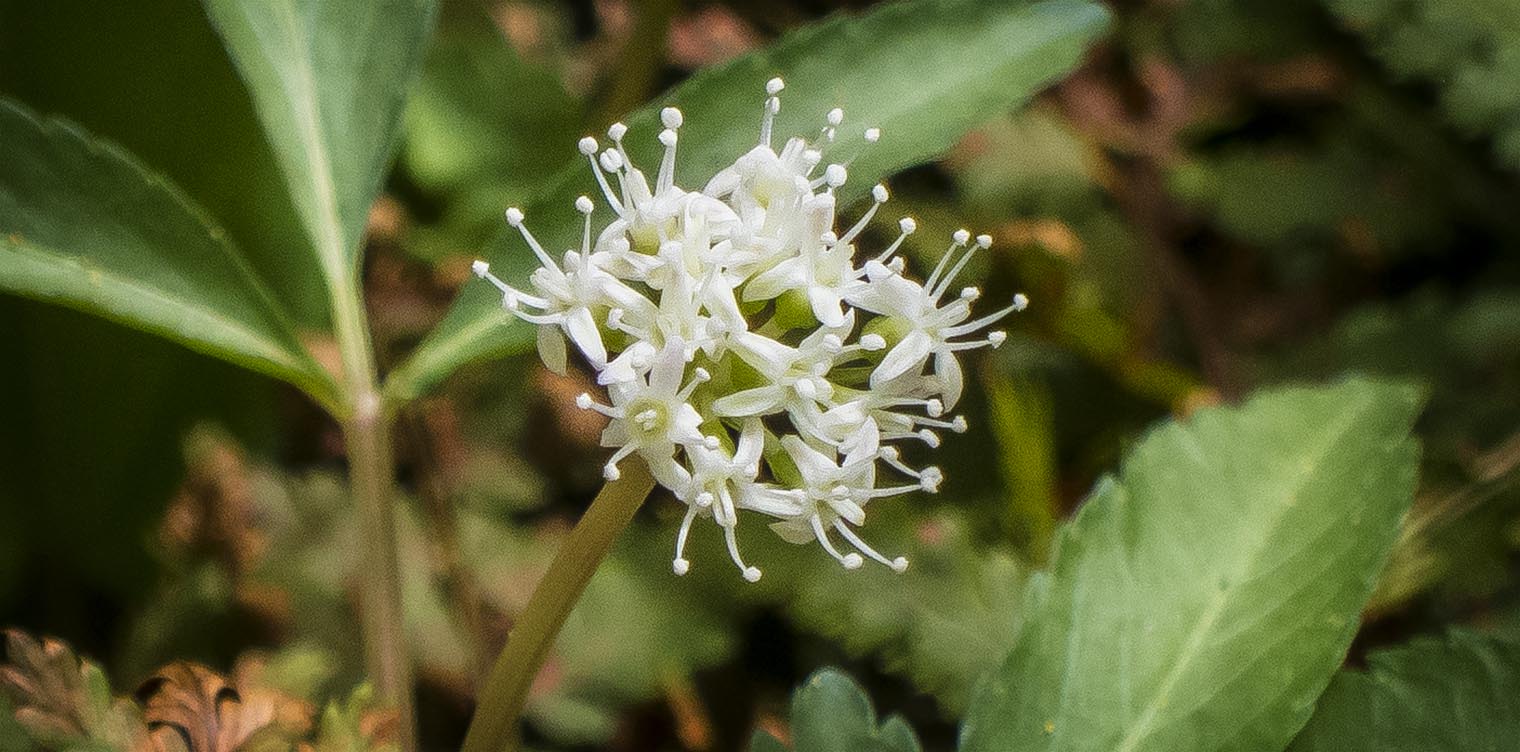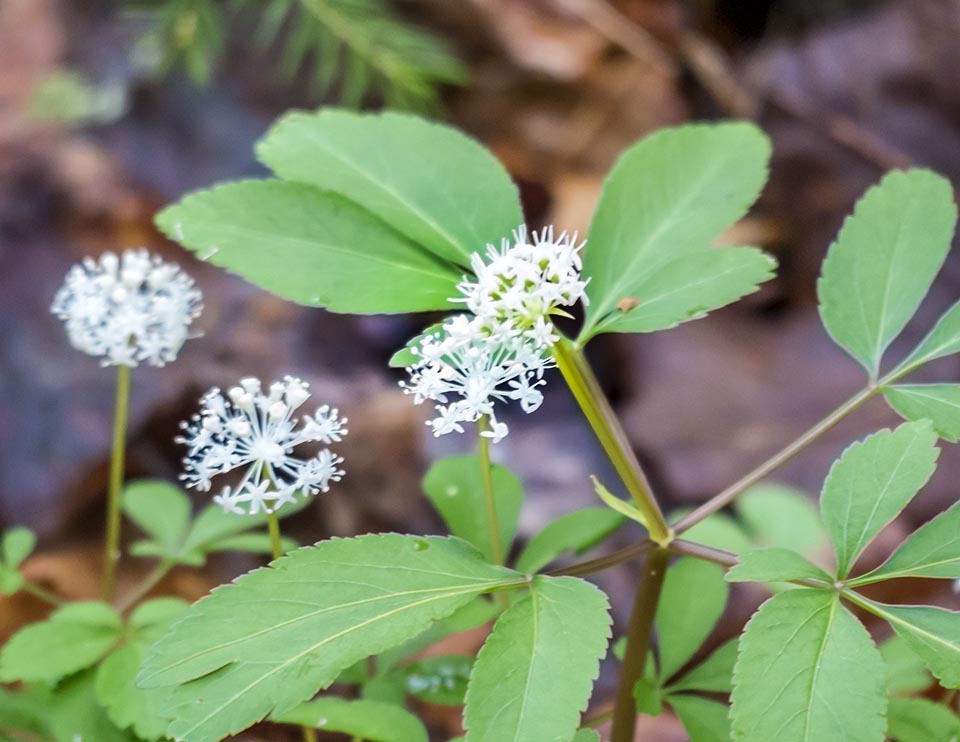Wildflowers of the Adirondacks:
Dwarf Ginseng (Panax trifolius)

Dwarf Ginseng (Panax trifolius) is a woodland perennial that produces an umbrella of tiny, delicate white flowers in early spring. It grows in northern hardwood forests in the Adirondack Mountains of upstate New York.
Dwarf Ginseng is a member of the Araliaceae (Ginseng) family. It is also known as Ground Nut. This is apparently a reference to the fact that the root, when eaten cold after boiling, reportedly tastes somewhat like nuts. The term "panax" is Greek for "all remedy" – a reference to the ancient Chinese belief that the plant was a panacea. The term "trifolius" means "three-leaves." This is a reference to the three leaflets which comprise the plant's compound leaves.
Identification of Dwarf Ginseng

Dwarf Ginseng is a small plant, about three to eight inches high. The stems are smooth and reddish green.
Dwarf Ginseng has medium green compound leaves with three (sometimes five) leaflets. The leaves have stalks about 1.4 to 1.25 inches long. The leaflets are stalkless, and they appear in a whorl around the stem about halfway between the base and flower cluster. The edges of the leaflets are finely toothed. The leaves are oblong to lance-like to elliptic. The middle leaflet is the largest; the side leaflets become progressively smaller.
Dwarf Ginseng flowers appear in a single round cluster at the top of the plant. The cluster is about an inch in diameter. The flowers are about 1/8 inch across, with five white petals and five white stamens. The flowers turn pale pink with age. Dwarf Ginseng blooms from mid-May through very early June in the Adirondack Park. On years that spring comes early, you may find it in bloom in early May. The flowers are followed by yellow, berry-like fruit later in the summer.
Uses of Dwarf Ginseng
The tuber of Dwarf Ginseng is said to be edible and can be eaten raw or boiled. This species, in contrast to the well-known herbal medicine ginseng, is not extensively used for medicinal purposes. Native Americans used it in the past to treat a wide variety of ailments. Cherokee tribes used it to treat chest pain, headaches, hives, colic, gout, rheumatism, and liver ailments. The Iroquois are said to have used it for chest pains and as a sports medicine.
Wildlife Value of Dwarf Ginseng
Dwarf Ginseng has no apparent use as a wildlife food or cover.
Distribution of Dwarf Ginseng
Dwarf Ginseng can be found in the northeastern United States and Canada, from Ontario east to Nova Scotia, south to Georgia and northwest to Kentucky, Indiana, and Minnesota.
In New York State, Dwarf Ginseng is found in many counties in the eastern part of the state. It is present in all counties in the Adirondack Park Blue Line, except Clinton and Fulton.
Habitat of Dwarf Ginseng
Dwarf Ginseng is a shade-tolerant plant. It grows in shade or partial shade. It prefers rich, well-drained soil.
Dwarf Ginseng can be found in northern hardwood forests, often under Sugar Maple. In the Adirondack Park, it occurs mainly in two ecological communities: Beech-Maple Mesic Forest and Maple-Basswood Rich Mesic Forest. Look for Dwarf Ginseng on trails that wind through deciduous forests, such as the Heron Marsh Trail and the Logger's Loop Trail at the Paul Smiths VIC.
References
Michael Kudish. Adirondack Upland Flora: An Ecological Perspective (The Chauncy Press, 1992), p. 177.
New York Flora Association. New York Flora Atlas. Dwarf Ginseng. Panax trifolius L. Retrieved 27 March 2017.
United States Department of Agriculture. The Plants Database. Dwarf Ginseng . Panax trifolius. Retrieved 23 April 2021.
United States Department of Agriculture. Forest Service. Plant of the Week. Dwarf Ginseng. Retrieved 27 March 2017.
iNaturalist. Dwarf Ginseng. Panax trifolius. Retrieved 23 April 2021.
iNaturalist. Adirondack Park Observations. Dwarf Ginseng. Panax trifolius. Retrieved 23 April 2021.
NatureServe Explorer. Online Encyclopedia of Life. Dwarf Ginseng. Panax trifolius - L. Retrieved 23 April 2021.
Native Plant Trust. Go Botany. Panax trifolius L. Dwarf Ginseng. Retrieved 23 April 2021.
Connecticut Botanical Society. Dwarf Ginseng. Retrieved 27 March 2017.
University of Wisconsin. Flora of Wisconsin. Panax trifolius L. Retrieved 23 April 2021.
Minnesota Wildflowers. Panax trifolius (Dwarf Ginseng). Retrieved 27 March 2017.
Lady Bird Johnson Wildflower Center. Panax trifolius L. Retrieved 23 April 2021.
Mark J. Twery, at al. Changes in Abundance of Vascular Plants under Varying Silvicultural Systems at the Forest Ecosystem Research and Demonstration Area, Paul Smiths, New York. USDA Forest Service. Research Note NRS-169. Retrieved 22 January 2017, p. 8.
New York Natural Heritage Program. 2021. Online Conservation Guide for Beech-Maple Mesic Forest. Retrieved 23 April 2021.
New York Natural Heritage Program. 2021. Online Conservation Guide for Maple-Basswood Rich Mesic Forest. Retrieved 23 April 2021.
Plants for a Future. Panax trifolius - L. Retrieved 22 April 2021.
University of Michigan. Native American Ethnobotany. A Database of Foods, Drugs, Dyes and Fibers of Native American Peoples, Derived from Plants. Panax trifolius L. Dwarf Ginseng. Retrieved 27 March 2017.
Doug Ladd. North Woods Wildflowers (Falcon Publishing, 2001), p. 160.
Lawrence Newcomb. Newcomb's Wildflower Guide (Little Brown and Company, 1977), pp. 286-287.
Roger Tory Peterson and Margaret McKenny. A Field Guide to Wildflowers. Northeastern and North-central North America (Houghton Mifflin Company, 1968) pp. 52-53.
National Audubon Society. Field Guide to Wildflowers. Eastern Region. (Alfred A. Knopf, 2001), pp. 356-357.
William K. Chapman, et al. Wildflowers of New York in Color (Syracuse University Press, 1998), pp. 22-23.
Anne McGrath. Wildflowers of the Adirondacks (EarthWords, 1981, 2000), p. 5, Plate 2.
